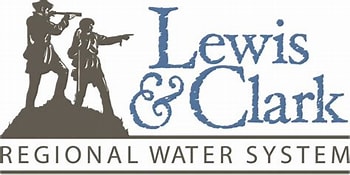Lewis & Clark Water coming soon - Chloramination Process
Chloramination Process Disinfecting our drinking water is an important health and safety measure that Sheldon provides for residents. In preparation for receiving water from the Lewis & Clark Regional Water System, the City of Sheldon will be changing its method of disinfection to chloramination the week of December 4, 2023.

Chloramination is a commonly used disinfection process, used by many including the Lewis & Clark Regional Water System. The use of chloramines or other disinfectants is required by EPA drinking water health standards and Iowa Dept. of Natural Resources requirements.
This change is intended to benefit our customers by reducing the levels of disinfection byproducts in the system while still providing protection from waterborne disease.
What is chloramination? Chloramination is the process of adding chloramine to drinking water to disinfect it and kill viruses, bacteria, and other organisms that cause illness. It is sometimes used as an alternative to chlorination. Chloramines are a group of chemical compounds that contain chlorine and ammonia. The particular type of chloramine used in drinking water disinfection is called monochloramine which is mixed into water at levels that are safe to drink but kill the organisms that cause illness.
Why switch from chlorine to chloramine disinfection? The U.S. Environmental Protection Agency (EPA) allows drinking water treatment plants to use chloramine and chlorine to disinfect drinking water. Research shows that chloramine and chlorine both have benefits and drawbacks.
Chlorine is a highly effective method of disinfection. However, while in the pipes it produces small amounts of chemicals (called “disinfection by-products”) if the source water has higher levels of dirt or organic carbon that may react with chlorine.
Chlorine is also used up quickly in water systems. Sometimes there is not enough chlorine left to kill harmful organisms in the water by the time it reaches the end of the pipes. Chloramine can last longer in the water pipes and produces fewer disinfection by-products. To meet EPA standards intended to reduce disinfection by-products, some water utilities are switching to chloramine. The City of Sheldon works hard to ensure proper disinfection of the water supply with all methods it uses.
Important info for fish owners: Similar to chlorine disinfection, chloramination can affect fish, reptiles, and amphibians. Like chlorine, chloramines can enter into a fish’s bloodstream through its gills, which may be harmful to the fish. Since Chloramines last longer in the water than chlorine, the chloramines must be removed from the water with a filter or additive. Chloramines take weeks, much longer than chlorine, to dissipate from the water.
Unlike humans and other household pets, fish, aquatic animals, reptiles and amphibians absorb water directly into the blood stream. Don’t keep these animals in water that contains chlorine or chloramine disinfectants. Chloraminated water may be toxic to fish. Fish owners should make sure the chemicals or filters they are using are designed for use in water that has been treated with chloramines. They may need to change the type of filter that they use for the fish tank. Unlike chlorine, chloramines cannot be removed by boiling water, adding salt, or letting water stand in an open container to dissipate. Products are available at aquarium supply stores that can remove chloramine. Ask a pet store about methods of removing disinfectants from water for these pets.
The small amount of chloramine added to water will not affect other pets (such as mammals and birds) and can be used regularly for watering and bathing animals.
Important info for dialysis providers/home dialysis: The change to chloramines can cause problems to persons dependent on dialysis machines. A condition known as hemolytic anemia can occur if the disinfectant is not completely removed from the water that is used for the dialysate. Dialysis facilities should prepare to adjust water purifications techniques for water used during dialysis treatments. The pretreatment scheme used for the dialysis units typically include some means, such as a charcoal filter, for removing the chloramine. Home dialysis users should consult the machine manufacturer for instructions on how to properly treat their water before use and double check for proper treatment of chloramine in the future.
Medical facilities should also determine if additional precautions are required for other medical equipment.
Will chloramine affect my water’s taste or smell? If you notice any change in the taste or smell of your water, it may be that the water treated with chloramine may have less of a “chlorine” taste and smell than water treated with chlorine.
(Source: CDC)